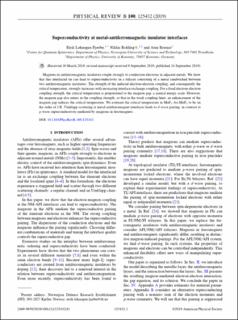Superconductivity at metal-antiferromagnetic insulator interfaces
| dc.contributor.author | Fjærbu, Eirik Løhaugen | |
| dc.contributor.author | Rohling, Niklas | |
| dc.contributor.author | Brataas, Arne | |
| dc.date.accessioned | 2021-10-26T13:19:35Z | |
| dc.date.available | 2021-10-26T13:19:35Z | |
| dc.date.created | 2019-09-30T07:44:27Z | |
| dc.date.issued | 2019 | |
| dc.identifier.issn | 2469-9950 | |
| dc.identifier.uri | https://hdl.handle.net/11250/2825765 | |
| dc.description.abstract | Magnons in antiferromagnetic insulators couple strongly to conduction electrons in adjacent metals. We show that this interfacial tie can lead to superconductivity in a trilayer consisting of a metal sandwiched between two antiferromagnetic insulators. The strength of the induced electron-electron coupling, and consequently the critical temperature, strongly increases with increasing interface exchange coupling. For a fixed electron-electron coupling strength, the critical temperature is proportional to the magnon gap, a natural energy scale. However, the magnon gap also enters in the coupling strength, so that in the weak coupling limit, an enhancement of the magnon gap reduces the critical temperature. We estimate the critical temperature in MnF2-Au-MnF2 to be on the order of 1 K. Umklapp scattering at metal-antiferromagnet interfaces leads to d-wave pairing, in contrast to p-wave superconductivity mediated by magnons in ferromagnets. | en_US |
| dc.language.iso | eng | en_US |
| dc.publisher | American Physical Society | en_US |
| dc.title | Superconductivity at metal-antiferromagnetic insulator interfaces | en_US |
| dc.type | Peer reviewed | en_US |
| dc.type | Journal article | en_US |
| dc.description.version | publishedVersion | en_US |
| dc.source.volume | 100 | en_US |
| dc.source.journal | Physical review B (PRB) | en_US |
| dc.identifier.doi | 10.1103/PhysRevB.100.125432 | |
| dc.identifier.cristin | 1730948 | |
| cristin.unitcode | 194,66,20,0 | |
| cristin.unitname | Institutt for fysikk | |
| cristin.ispublished | true | |
| cristin.fulltext | original | |
| cristin.qualitycode | 2 |
Tilhørende fil(er)
Denne innførselen finnes i følgende samling(er)
-
Institutt for fysikk [2650]
-
Publikasjoner fra CRIStin - NTNU [37145]
